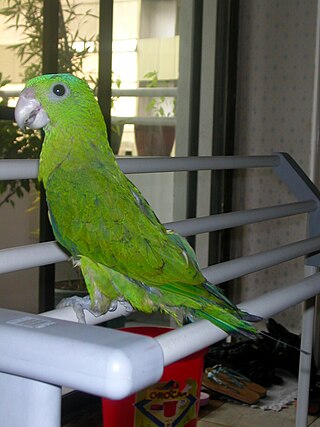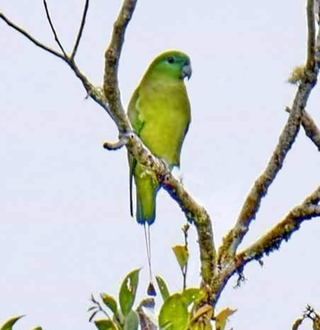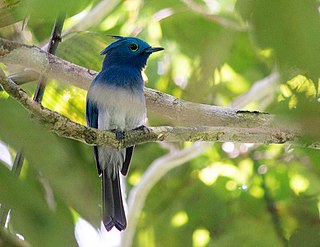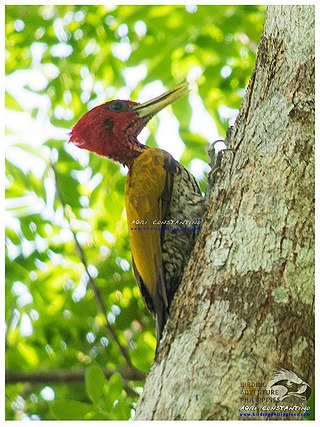
The blue-crowned racket-tail is a parrot found on all the larger islands of the Philippines except Palawan and Panay islands. It is 27 cm, basically green with a blue crown, bluish undertail, whitish beak, and dark underwings with green coverts. The blue-headed racket-tail was formerly included in this species.

The blue-headed racket-tail, also known as the Palawan racket-tail and locally as kinawihan, is a parrot found in the western Philippines around Palawan. The species was formerly considered conspecific with the blue-crowned racket-tail. It is locally known as 'kilit'. It inhabits humid lowland forest in small flocks. It is threatened by habitat destruction and limited trapping for the cage-bird trade.

The yellow-breasted racket-tail is a species of parrot in the family Psittaculidae. It is endemic to Indonesia where it is found in Sulawesi's northern peninsula and the Togian Islands in the Gulf of Tomini. Its natural habitat is subtropical or tropical moist lowland forests.

The Buru racket-tail, is a species of parrot in the family Psittaculidae. It is endemic to the forest on the island of Buru, one of the Maluku Islands of Indonesia.

The montane racket-tail or the Luzon racket-tail, is a species of parrot in the family Psittaculidae. It was previously conspecific with the Mindanao racket-tail. It is endemic to the mountains of northern Luzon in the Philippines. It is threatened by habitat loss and the cage bird trade.

The golden-mantled racket-tail is a species of parrot in the family Psittaculidae. It is endemic to Indonesia. Its natural habitats are subtropical or tropical moist lowland forest and subtropical or tropical moist montane forest up to an altitude of about 3,000 metres (9,800 ft).

The blue-winged racket-tail or Sulu racquet-tail is a species of parrot in the family Psittaculidae. It is endemic to Tawi-Tawi island in the Philippines and is one of the most endangered parrots in the world. It is threatened by habitat loss and the poaching for the cage-bird trade.

The Mindanao racket-tail is a species of parrot in the family Psittaculidae. It is endemic to Mindanao in the Philippines. It was previously conspecific with the Luzon Racket-tail. Two subspecies are recognized: the nominate waterstradti in the south-east, and malindangensis in the west. Its natural habitat is

The black-bibbed cicadabird or black-bibbed cuckooshrike is a species of bird in the family Campephagidae. It is endemic to the Philippines. The species is elusive and poorly known.

The white-winged cuckooshrike, also known as white-winged cicadabird or white-winged graybird, is a species of bird in the family Campephagidae. It is endemic to the Philippines found on the islands of Negros, Panay and formerly on Guimaras. Some taxonomists place this species in the genus Analisoma.

The yellow-crowned flowerpecker is a species of bird in the family Dicaeidae. It is endemic to Luzon Island in the Philippines. The flame-crowned flowerpecker, which is endemic to Mindanao, was formerly considered conspecific. Its natural habitat is tropical moist montane forest. It is becoming rare due to habitat loss.

The celestial monarch is a species of bird in the family Monarchidae, and one of the most attractive of all the monarch flycatchers, with its spectacular blue crest and large greenish-yellow wattle. It is endemic to the Philippines with its extant range being in Luzon, Samar, Mindanao Tawi-Tawi and Basilan and it being possibly extinct on Negros and Sibuyan Island. It is often observed in mixed flocks with other birds such as blue fantails, rusty-crowned babblers, rufous paradise flycatchers, both short-crested monarchs and black-naped monarchs and other small forest birds. Its natural habitat is tropical moist lowland forests up to 750 masl. It is one of the most sought after birds by birdwatchers in the Philippines and in the world.

The azure-breasted pitta is a species of bird in the family Pittidae. It is a striking and colorful bird having colors of red, azure, green, black and white, It is endemic to the islands of Mindanao, Bohol, Leyte and Samar in the Philippines. Its natural habitat is tropical moist lowland forest. It is threatened by habitat loss.

The golden-crowned babbler is a species of bird in the family Zosteropidae. It is endemic to the Philippines only being found in the moist tropical forest in Northern Luzon. It is threatened by habitat loss.

The Luzon striped babbler is a species of bird in the family Zosteropidae. It is endemic to the Philippines, where it is only found in northern Luzon and in Bataan.

The Negros scops owl, also known as the Visayan scops owl, is an owl, endemic to the islands of Negros and Panay in the Philippines, belonging to the family of the typical owls Strigidae. It was formerly classified as a subspecies of the Philippine scops owl. It is threatened by habitat loss and hunting for the pet trade.

The red-headed flameback is a species of bird in the family Picidae. It is endemic to the Philippines only being found in the region of Palawan in the islands of Balabac, mainland Palawan, Busuanga and Calamian. It is one of the most spectacular flamebacks with its bright red head and yellow-green back. It is sometimes considered a subspecies of the greater flameback. It is found in moist lowland forests including primary, secondary and even plantations and clearings provided there are still standing trees. It is threatened by habitat loss.
The Cebu boobook or Cebu hawk-owl is a species of owl in the family Strigidae. It is endemic to the Philippines. It was formerly considered a subspecies of the Philippine hawk-owl, but was reclassified in 2012, as voice and other data suggested placement in a distinct species.
The Sulu boobook or Sulu hawk-owl is a species of owl in the family Strigidae. It is endemic to the Sulu Archipelago in the Philippines. It was previously known as a subspecies of the Philippine hawk-owl, but was reclassified in 2012, as voice and other evidence suggested it was a distinct species. It is found in tropical moist lowland forest. It is threatened by habitat loss.
The Mindoro racket-tail is a species of parrot in the Psittaculinae family. It was formerly considered conspecific with the blue-crowned racket-tail. It is endemic to the island of Mindoro in the Philippines and it occurs in tropical moist lowland forest. It is threatened by habitat loss and trapping for the cage-bird trade.



















